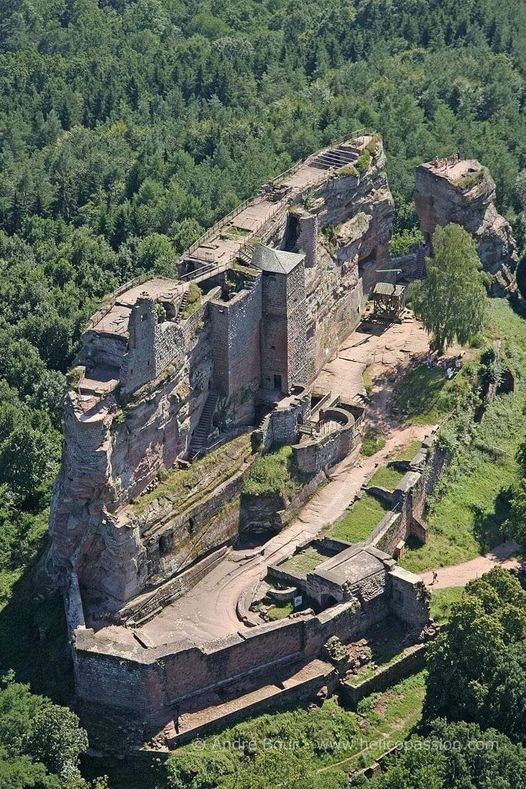In the heart of the Northern Vosges mountains of France, an extraordinary tale of resilience, ambition, and historical legacy unfolds—one that continues to captivate historians, travelers, and lovers of medieval architecture. Amidst the rolling hills and dense forests of the commune of Lembach, Fleckenstein Castle rises majestically from the earth, its 52-meter-long form etched into the rugged stone like a vessel emerging from the landscape. This remarkable structure, shaped over centuries, not only bears witness to the strategic and artistic vision of its builders but also stands as a living symbol of human determination and cultural endurance.

The origins of Fleckenstein Castle trace back to the year 1165, when it was first constructed under the direction of the noble Fleckenstein family. What began as a modest fortification soon evolved into a formidable stronghold, reflecting both the ambition and the influence of its founding family. Over the course of nearly 500 years, the Fleckensteins expanded and fortified the castle, transforming it into a bastion of power that commanded the surrounding region. It was not merely a military installation—it was a symbol of authority and prestige. Historical documents, along with a rare 16th-century tapestry that has been carefully preserved, depict the castle in its Renaissance glory, showcasing elaborate architecture and the vibrant life of a medieval fortress.
However, Fleckenstein Castle’s significance extended far beyond its impressive facade. Strategically perched on a rocky outcrop, it was a key point of defense and governance for the region. Its position allowed it to control important trade routes and protect the surrounding lands, reinforcing the Fleckenstein family’s dominance. But with power and prominence came peril, and the castle’s storied history includes numerous sieges and assaults.
Throughout its existence, Fleckenstein Castle weathered many conflicts, but it was during the Nine Years’ War in the late 17th century that it faced its most severe trials. French forces, determined to weaken the region’s strongholds, captured the castle twice during the war. Then, in 1689, under the orders of General Mélac, the fortress was deliberately and thoroughly destroyed in a devastating act of military strategy. What had once been a symbol of might and grandeur was reduced to ruins, its proud towers and walls collapsing under the weight of cannon fire and the passage of time.
In the centuries that followed, Fleckenstein Castle remained largely abandoned. The once-vibrant fortress lay in a state of decay, its stones scattered and weathered by the elements. Nature slowly reclaimed the site, and for nearly two hundred years, the castle’s grandeur faded into memory, preserved only in the tales of local residents and the crumbling remains left to the wilderness. It seemed that the story of Fleckenstein might end there, lost to history as so many monuments of the past have been.
Yet, the enduring spirit of this ancient fortress refused to be extinguished. In 1870, the castle’s historical importance was rediscovered by scholars and preservationists who recognized the need to protect and honor its legacy. Their dedication marked the beginning of a new chapter for Fleckenstein. Restoration efforts commenced, breathing life back into the ruins and halting the decline that had plagued the site for so long. Important work was undertaken in 1908 and again in 1958, as experts and craftsmen meticulously preserved the remaining structures and reinforced the castle’s foundation, ensuring its survival for future generations.
Today, Fleckenstein Castle is more than just a relic of the past—it is a powerful symbol of endurance. Each restored stone and carefully preserved wall tells a story of survival, of a community and nation that refused to let their cultural heritage be forgotten. The castle serves not only as a monument to medieval engineering and feudal history but also as a tribute to the human spirit’s capacity to rebuild and honor the past.
Visitors who explore Fleckenstein Castle today are treated to a unique and immersive experience. The castle’s distinctive boat-like form, carved directly into the rocky mountainside, continues to captivate all who see it. Walking through its restored passages and climbing its ancient staircases, tourists can almost hear the distant clang of swords, the murmur of strategy among knights, and the echoes of life that once animated these halls. The site offers not just a glimpse into architectural brilliance but also an emotional connection to the people who lived, fought, and thrived there centuries ago.
Moreover, Fleckenstein Castle is an invaluable educational resource. It offers insights into medieval life, military strategy, and the evolution of fortifications in response to changing political landscapes. For historians, it serves as a case study in the rise and fall of noble families, the impact of war on cultural landmarks, and the importance of preservation efforts in maintaining a tangible link to our shared past. For casual visitors, it’s an opportunity to step back in time and marvel at the artistry and determination that shaped one of France’s most iconic medieval castles.
As a cherished landmark in the Northern Vosges region, Fleckenstein Castle continues to inspire. It stands as a bridge between past and present, a testament to the resilience of those who built it, defended it, and ultimately restored it. Its story is one of ambition, destruction, rediscovery, and renewal—a narrative that reminds us of the power of human endeavor and the importance of safeguarding history. Each stone carries with it not just the weight of centuries, but the enduring message that even in ruin, there is potential for revival. Through Fleckenstein Castle, we are reminded that history lives on, not only in books and memories but in the very structures that bear witness to the passage of time.





